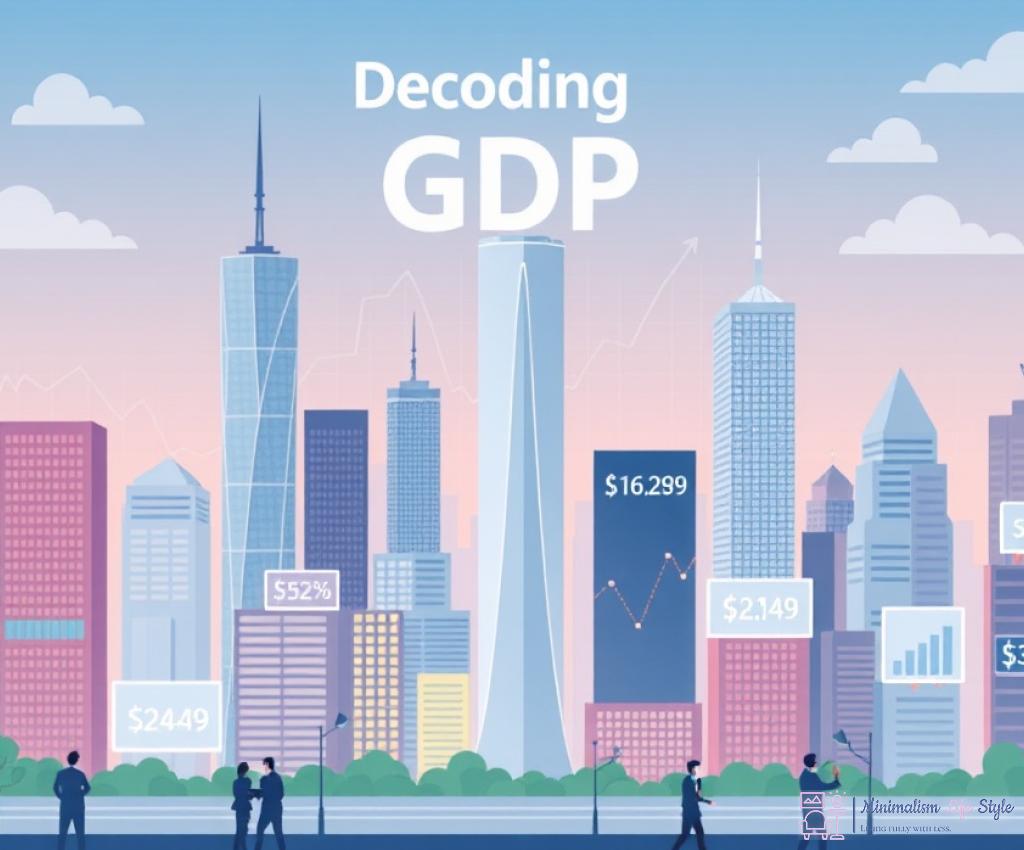Decoding GDP: The Heartbeat of the Economy

Gross Domestic Product, commonly known as GDP, serves as a critical indicator of a nation’s economic health. Think of it as the economic report card that reflects the total value of all goods and services produced over a specific time period within a country. Understanding GDP is essential for everyone, from policymakers to everyday citizens, as it influences decisions regarding employment, inflation, and economic policy.
To truly decode GDP, one must examine its components. GDP is typically calculated using three primary approaches: production, income, and expenditure. Each approach provides unique insights into economic activity, but they ultimately converge to yield the same GDP figure.
| Approach | Description |
|---|---|
| Production | Measures the total output of goods and services. |
| Income | Calculates the total income earned by factors of production. |
| Expenditure | Assesses the total spending on the nation’s final goods and services. |
The expenditure approach is the most commonly referenced, comprising four major components: consumption, investment, government spending, and net exports. Understanding how these elements interact can provide a clearer picture of economic dynamics.
Monitoring GDP growth rates is akin to checking the pulse of the economy. A rising GDP indicates a healthy, expanding economy, while a declining GDP can signal recessionary conditions. But it’s important to note that GDP growth alone doesn’t paint the complete picture. Other factors, such as income distribution and environmental sustainability, also play a crucial role in assessing overall economic well-being.
Key Takeaways:
- GDP is a comprehensive measure of a nation’s economic activity.
- The three approaches to calculating GDP provide different perspectives.
- GDP growth rates indicate economic health but must be considered alongside other factors.
Unemployment Rate: A Window into Economic Health
When sifting through the myriad of economic indicators, the unemployment rate stands out as a pivotal metric that provides insight into the labor market’s health. It serves as a reflection of how many individuals are actively seeking employment yet unable to find work, painting a vivid picture of economic vitality or distress. Understanding this indicator is crucial for grasping the overall economic landscape of a nation.
The unemployment rate is more than just a numerical figure; it’s a narrative of economic conditions. A high unemployment rate can signify economic downturns, business contractions, or even shifts in industry demands. Conversely, a low unemployment rate often reflects a booming economy where job opportunities abound. This rate is calculated by dividing the number of unemployed individuals by the total labor force, making it a fundamental gauge for economists and policymakers alike.
To decode the unemployment rate further, it’s essential to recognize the different types of unemployment, each with its own implications:
- Cyclical Unemployment: This type arises from economic downturns, indicating that as businesses struggle, they reduce their workforce.
- Structural Unemployment: Occurs when there’s a mismatch between workers’ skills and job requirements, often driven by technological advancements or industry shifts.
- Seasonal Unemployment: This reflects the fluctuations in demand for labor at different times of the year, common in industries like agriculture and tourism.
- Frictional Unemployment: A natural form of unemployment where individuals are temporarily between jobs, often attributed to voluntary transitions.
Each type plays a role in understanding the broader economic context, showcasing the dynamic interplay between job availability and the workforce.
The unemployment rate not only affects individuals but resonates through the economy at large. High unemployment can lead to decreased consumer spending, which may, in turn, slow economic growth. On the flip side, a low unemployment rate can fuel inflationary pressures as companies compete for a limited pool of workers. Policymakers must balance these influences, making the unemployment rate a critical focal point in economic strategy.
Inflation: Understanding Price Changes Over Time
Inflation is the silent force that shapes our economic landscape, affecting everything from your morning coffee to long-term investments. As prices rise steadily over time, the purchasing power of your money diminishes, making it crucial to grasp the nuances of inflation. Understanding this phenomenon is not just for economists; it directly impacts every consumer and investor. With inflation rates fluctuating, keeping an eye on these changes can help you make informed financial decisions and prepare for future economic conditions.
At its core, inflation arises from several key factors that can be both complex and interrelated. Demand-pull inflation occurs when the demand for goods and services exceeds supply, leading to higher prices. Conversely, cost-push inflation happens when production costs increase, prompting businesses to raise their prices to maintain profit margins. Moreover, built-in inflation emerges from a cycle of wage increases that compel businesses to adjust their prices, creating a persistent upward trend. Recognizing these underlying causes can enhance your understanding of how inflation affects your budget and savings.
The effects of inflation ripple through the economy, influencing everything from savings accounts to investment portfolios. For consumers, rising prices can erode savings and force adjustments in spending habits. For instance, a higher inflation rate can lead to increased costs of living, making it essential to strategize about budgeting and financial planning. On the investment front, inflation can alter the landscape significantly; certain assets may thrive while others falter. Understanding how inflation interacts with interest rates and economic growth can empower you to navigate your financial choices wisely. In a world where economic indicators dictate the rhythm of our financial lives, grasping the intricacies of inflation is not just advantageous; it’s essential for maintaining economic resilience.
Consumer Confidence: The Pulse of Spending Habits
Consumer confidence is more than just a number; it serves as a reflection of how optimistic or pessimistic consumers are regarding their financial situation and the overall economy. This sentiment significantly influences spending behavior, making it a critical indicator for economists and policymakers alike. When consumers feel secure in their economic prospects, they are more likely to spend money, fueling economic growth. Conversely, a dip in confidence can lead to reduced spending, which may slow down economic momentum. In essence, tracking consumer confidence is akin to measuring the heartbeat of consumer behavior—vital and revealing.
Several variables come into play when assessing consumer confidence, each contributing to the broader economic narrative. Factors such as employment levels, inflation rates, and economic news can shape consumer perceptions. For instance, a stable job market often correlates with higher confidence levels as individuals feel more secure in their financial situations. On the other hand, rising inflation can create anxiety, leading to cautious spending habits. Additionally, major economic events, such as financial crises or significant policy changes, can have an immediate impact on consumer sentiment. All these elements intertwine, creating a complex tapestry of perceptions that ultimately influence economic activity.
The implications of consumer confidence extend far beyond individual spending habits. When confidence is high, businesses may experience increased sales, prompting them to invest in expansion, hire more staff, and innovate. This creates a positive feedback loop that benefits the economy. However, when consumer confidence wanes, businesses may pull back on investments, leading to slower growth and potential layoffs. The result is a delicate balance that policymakers must navigate. By monitoring consumer confidence, they can gauge when to implement measures that encourage spending, such as tax cuts or stimulus packages. Thus, understanding this indicator is essential not only for consumers making personal financial decisions but also for businesses strategizing for the future and policymakers crafting economic policies.
Interest Rates: The Cost of Borrowing Explained
Interest rates serve as a fundamental pillar in the economic framework, acting as the cost of borrowing money and the reward for saving. These rates, set by central banks and influenced by various economic factors, can significantly impact consumer behavior and business investments. When rates are low, borrowing becomes affordable, encouraging consumers to finance purchases, while businesses may seize the opportunity to invest in expansion. Conversely, higher interest rates can curtail spending and investment, creating a ripple effect throughout the economy.
The mechanics of how interest rates operate are intricate yet crucial for any minimalist seeking to navigate economic waters. In essence, interest rates are influenced by the supply and demand for money. When the economy is strong, demand for loans increases, leading to higher rates. On the other hand, in times of economic downturn, central banks may lower rates to spur borrowing and investment. This dynamic showcases the delicate balance between economic growth and inflation control, as policymakers aim to maintain stability while fostering a healthy economic environment.
Changes in interest rates can have profound implications not only for individual consumers but also for the economy at large. For instance, a rise in rates can lead to an increase in monthly mortgage payments, which may deter potential homebuyers and suppress the housing market. Additionally, businesses may delay or scale back investments, impacting job creation and overall economic growth. Understanding these connections is vital for anyone looking to comprehend the economic landscape. As such, keeping an eye on interest rate trends becomes essential for making informed financial decisions, whether you’re contemplating a new home purchase or considering investments in the stock market.




